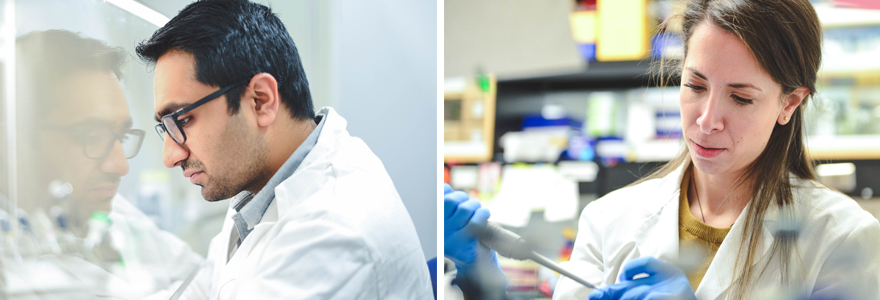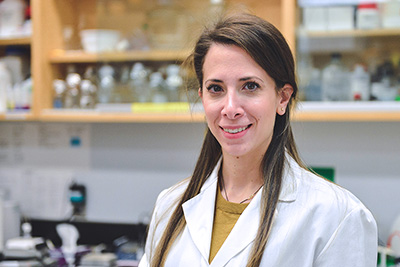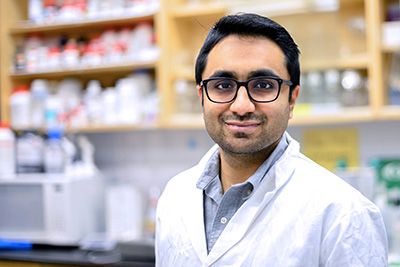Back to the lab

By Max Martin, MMJC’19
Two PhD candidates at Schulich Dentistry are taking their clinical expertise back into the lab, marrying hands-on experience treating patients with basic science research in an effort to develop novel dental advancements.
Drs. Shariq Najeeb and Georgia Nikoloudaki, both working under supervisor Douglas Hamilton, PhD, are keeping practical clinical applications front of mind as they pursue their graduate research.
For endodontist Dr. Nikoloudaki, the hope is to bridge the gap between basic research and clinical practice.
“In order to lessen this gap, we need high-quality dental research that is applicable to clinical practice,” she said. “Incorporating advances in fields like bioengineering, stem cells and genetics into dental research will allow us to explore new problems and improve the field of dentistry.”
As a clinician, Dr. Nikoloudaki was motivated to better understand what happens in basic science labs and see how it can be incorporated into actual practice. “Being a clinician first allows me to form questions that are more clinically relevant,” she said.
Dr. Nikoloudaki is studying the role of a protein called periostin in scar formation after cleft palate repair surgery. Understanding how a lack of this protein affects wound healing in the mouth could lead to the development of new biomaterials that would result in less scarring post-surgery.
In Canada, one in 790 babies are born with a cleft palate each year. Surgery is required during infancy, which results in scarring that can prevent proper development of the face and mouth. Ongoing treatment and procedures are usually required, causing a heavy financial and psychological burden on the patient and their family.
 “We anticipate that the results of this study will help us gain a better understanding of the mechanisms of healing in the mouth and could provide a basis for the development of novel biomaterials that enhance healing,” Dr. Nikoloudaki said.
“We anticipate that the results of this study will help us gain a better understanding of the mechanisms of healing in the mouth and could provide a basis for the development of novel biomaterials that enhance healing,” Dr. Nikoloudaki said.
Another goal of merging both research and clinical practice is that she’ll be able to share her dual-knowledge with future dental students and graduate trainees as she continues teaching.
“Why I am actually crossing this line is because I really want to not only be an clinical educator in endodontics, but also to supervise grad students in their research,” Dr. Nikoloudaki explained. “As a clinician-scientist, my aims for my academic career is not only to transmit knowledge to the students, but to generate new knowledge and apply that knowledge to society.”
Dr. Nikoloudaki chose to focus on scarring specifically because it would expose her to a variety of research techniques, experiment designs and methodologies that can be directly applied to endodontics.
“Having extensive research, clinical and teaching experience allows me to incorporate the importance of research throughout dental education,” she said. “I believe that this approach will benefit our profession and improve dental care, as it will prepare educators and clinicians to adapt to changes in practice and in the profession that the future requires.”
Meanwhile, in the same laboratory in the Dental Sciences Building, Dr. Najeeb is also applying his clinical experience to his PhD research.
Najeeb is working to produce a novel tissue regeneration material for individuals who have suffered bone loss due to periodontal disease.
“In many cases, periodontal disease is so chronic it is asymptomatic, so a lot of patients don’t come into the clinic until they have severe bone loss,” Najeeb said. “Our research will help to actually regenerate the bone and go hand-in-hand in patient education and care.”
The multi-functional membrane he’s helping to develop would be placed surgically and be an important tool in sparking the regeneration process, rather than just trying to fill the space left by bone loss.
 Dr. Najeeb is drawing heavily on his work as a clinician in his research, taking into consideration clinical efficacy, potential adverse effects and even aspects like how the material would be handled by dentists and surgeons.
Dr. Najeeb is drawing heavily on his work as a clinician in his research, taking into consideration clinical efficacy, potential adverse effects and even aspects like how the material would be handled by dentists and surgeons.
One moment in the clinic was particularly impactful for Dr. Najeeb – staying after hours at the clinic to help a man brought to tears from the severe pain of a periodontal abscess.
“Drawing on my background as a clinician and now as a researcher has helped me integrate different concepts between the two domains,” Dr. Najeeb said.
He was drawn back to the lab by the desire to have an even greater impact on patient care.
“In clinics, you do have that individual contact with the patient. But if you’re doing research, you have the opportunity to make a difference in a community as a whole,” Dr. Najeeb explained.
“We do have communities here in Canada and worldwide where there is health care inequity,” he said. “I think if you do research, you have the opportunity and privilege to work toward easing that inequality and can have a large-scale impact.”
But combining the two – research and clinical applications – is what inspires Dr. Najeeb the most.
“I think collaboration is the most important thing,” he said. “It is fundamental toward the application of novel research ideas in the clinics. If there is no communication between researchers and clinicians, then we would not have a lot of modern techniques being used today.”








